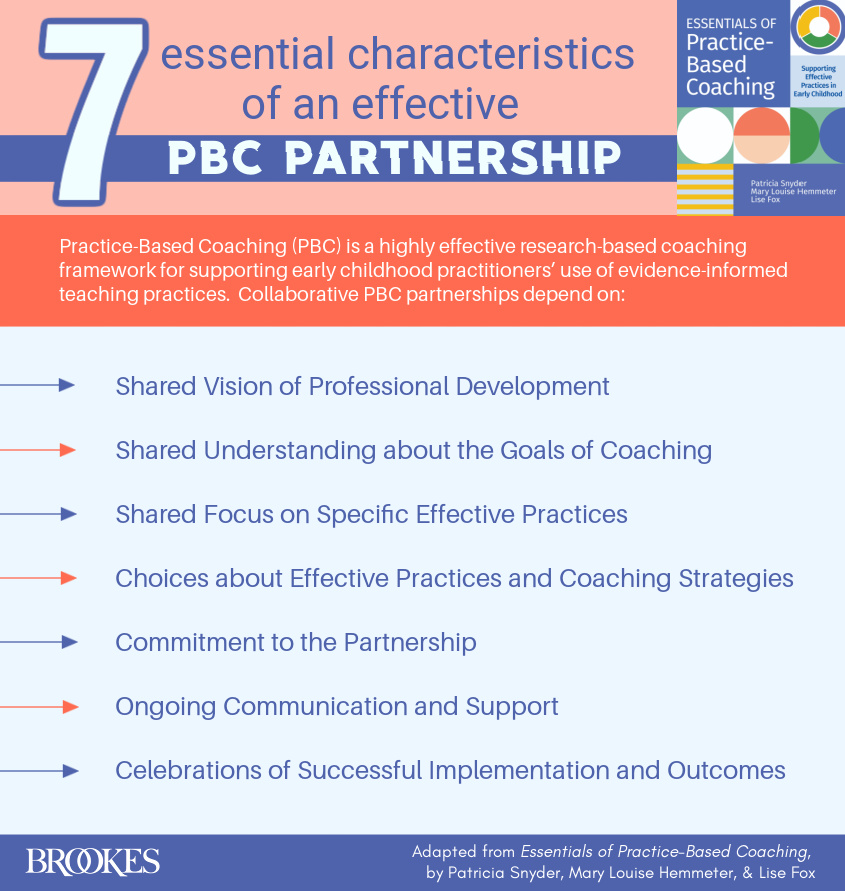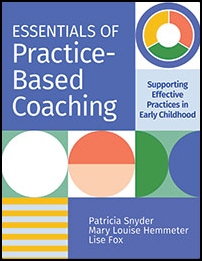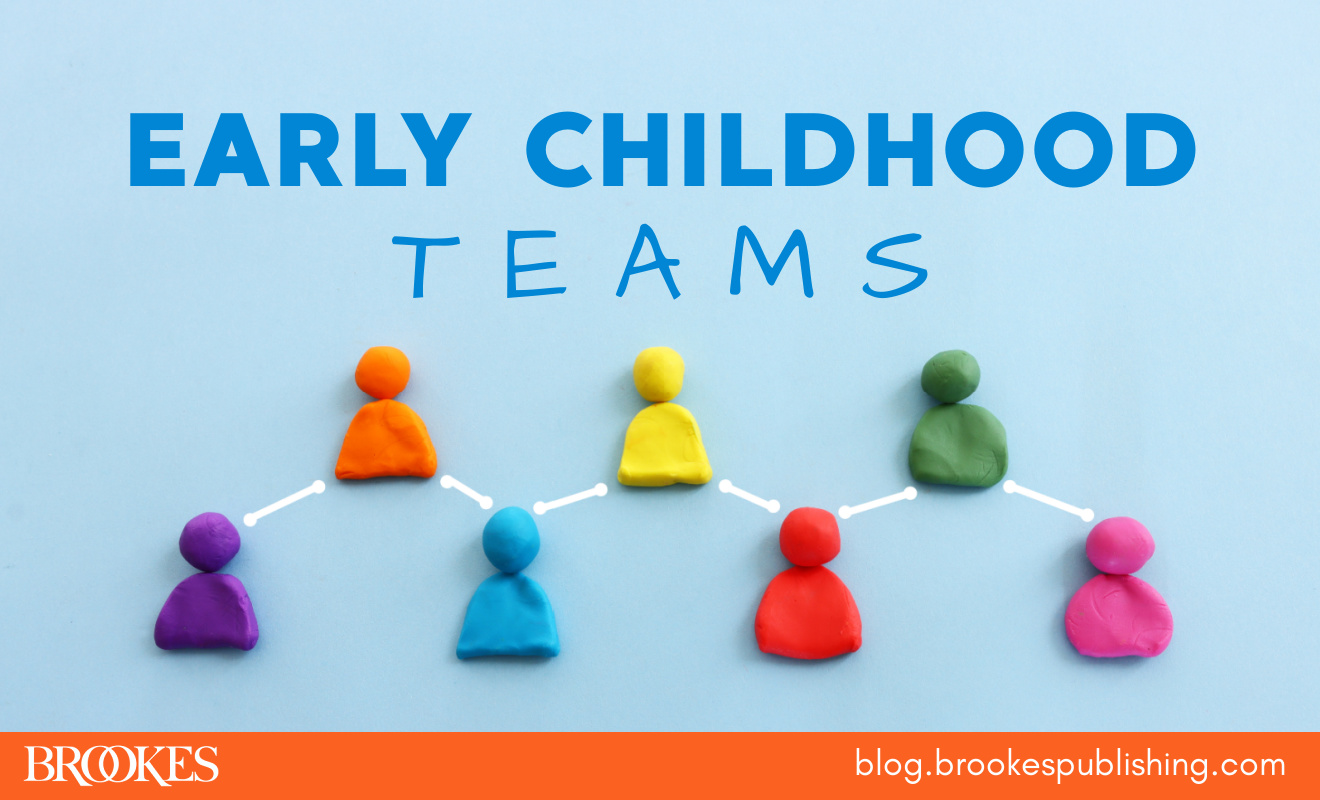If you’re an early childhood professional, you know that applying evidence-based practices in your daily work is key to achieving your ultimate goal: positive developmental and learning outcomes for infants, toddlers, and young children. Practice-Based Coaching (PBC) is a proven framework for helping professionals learn and implement these effective practices. Used widely across the U.S. and around the world, PBC is a research-based approach that pairs professionals with coaches in a collaborative partnership; together, they assess the strengths and needs of the coachee and design a plan for implementing effective practices.
The new book Essentials of Practice-Based Coaching, by Patricia Snyder, Mary Louise Hemmeter, & Lise Fox, is the first to offer a comprehensive introduction to this popular coaching approach and practical guidance on how to implement it with fidelity. In today’s blog post, adapted from the book, you’ll get a quick introduction to 7 key characteristics of a successful PBC partnership. Read on to learn what it takes to form a strong coach/coachee partnership, and then explore the book for a complete guide to PBC.

Download the infographic
For a quick snapshot of an effective PBC partnership, click the link below to download this handy infographic.
1. Shared Vision of Professional Development
The first step toward developing a successful coaching partnership is the coach and coachee collaborating on a shared vision of adult learning and professional development—and creating opportunities for the coachee to nurture that vision through their daily work. Typically, the first few meetings of a new partnership involve drawing connections between content or strategies provided by the coach and the coachee’s own practice experiences. Coaches highlight practices that have been proven to support healthy child development, identify which of the coachee’s existing strengths and priorities are suited to implementation of those practices, and then work with the coachee to determine ways they might strengthen their practice.
A shared professional vision can naturally lead to situations where partners are comfortable opening up to each other about their successes, struggles, fears, and frustrations. This can be helpful, but coaches should keep in mind that PBC is a goal-oriented professional partnership, and resist simply becoming a sympathetic ear for the coachee. Effective coaches not only recognize the emotions that can stem from real-world learning experiences, but also ensure that they help coachees channel those feelings into constructive planning.
2. Shared Understanding About the Goals of Coaching
For a PBC partnership to be productive, it’s essential that the coach and coachee also have a shared understanding about the specific goals of coaching. Both members of the coaching partnership should consider the following question: Why is coaching happening in the first place? Answers might include: to work toward implementation of a new curriculum or program, to help reach a program’s school readiness goals, or to aid in IEP implementation for children with or at risk for disabilities.
Members of a coaching team often find it helpful to create a written agreement that details the goals and roles for both the partners. Each agreement will be specific to the needs and priorities of the people involved, but there are common elements that can be found in almost all coaching pacts. Consider details like:
- When and how frequently will coaching sessions occur?
- What is the coach’s role during an observation?
- How will the coach and coachee prepare for goal-setting, observation, reflection, and feedback?
- What information is considered confidential and what might be shared with others?
- What data will be collected as part of the coaching, and why?
Coaches who are external consultants or work for third-party training programs will also need to spend some time learning how coaching is viewed within this school or program. For example:
- Has PBC been adopted program-wide or does the coachee alone require support?
- How has PBC been introduced, and is coaching considered voluntary or mandatory?
- Is coaching seen as a punishment within the program to correct a problem, or as a professional development opportunity?
- Is coaching aligned with a specific curriculum or initiative, and what are the coachee’s feelings about that curriculum or initiative?
If a coach understands how a program’s leadership has framed PBC within their organization, they’ll be better equipped to engage with their coaching partners and skillfully guide the development of evidence-informed teaching practices.
Both members of the coaching partnership should consider the following question: Why is coaching happening in the first place?
3. Shared Focus on Specific Effective Practices
After coaching partners have established explicit roles and goals within the PBC framework, they can begin to draw up a set of effective practices to support child development and learning. Part of a coach’s job is to help the coachee identify a manageable number of clearly defined, observable strategies that they feel confident enough to implement in a practice context.
Concentrating on a limited number of practices in each coaching cycle is helpful for several reasons:
- It allows coaches to avoid general assessments of practice quality, which might feel overwhelming to a coachee
- It helps coaching partners steer clear of potential “gotcha” moments in which a coachee might feel defensive about a coach’s feedback
- It builds coachee confidence and independence
- It encourages a spirit of experimentation and curiosity rather than a self-conscious feeling that they have to be “perfect” or know everything
A committed partnership evolves over time—and when partners can rely on one another, the collaboration will benefit them both.
4. Choices about Effective Practices and Coaching Strategies
Throughout the PBC process, collaborative partners share decision-making related not only to content (effective practices being learned by the coachee), but also structures (how the coachee will receive the coaching) and processes (supportive coaching interactions).
Successful PBC partners ask and answer critical questions that will guide and shape the coaching experience, including:
- When and how will the coachee be observed in the practice setting?
- Will the coach model or demonstrate practices?
- What data would be useful to the coachee?
- Will the entire team be coached or just the lead teacher?
When partners work together from the beginning to make decisions about which types of interactions and strategies they each prefer, the coaching partnership is more likely to be productive and successful.
5. Commitment to the Partnership
In any coaching partnership, follow-through is key: each partner must commit to agreed-upon goals, action plans, and coaching structures and processes. The partners should:
- Refer to and uphold the coaching agreement
- Ensure that all meetings start and end on time
- Respect each other’s schedules
- Communicate changes in advance using preferred methods (e.g., text, email, message left at front desk)
- Honor confidentiality by not sharing details of coaching conversations with others
- Stay sensitive to one another’s strengths and needs throughout the process
A committed partnership evolves over time—and when partners can rely on one another, the collaboration will benefit them both.
6. Ongoing Communication and Support
Clear and consistent communication is important in any successful partnership. To build trust and demonstrate respect, coaches should provide ongoing communication and support to their coachee, through actions like:
- Calling ahead if running late
- Rescheduling a meeting when a practitioner is in the midst of an emergency
- Sending an email with notes summarizing a coaching conversation
- Texting their coachee after a celebration or difficult day
- Dropping a handwritten note in the school mailbox to recognize an accomplishment
Collaborative partners should also recognize the fact that adults have complex lives, and that family, health, financial, and job stressors affect both coaches and coachees. A sensitive coach shows knowledge of the coachee’s situation and adjusts accordingly: “I know your licensing visit is in 2 weeks, so would you like to wait until that’s over for my next visit?” or “I can see that these last few weeks have been stressful for your family. Let’s take a second to acknowledge all that you’ve got going on right now…” Effective coaches also acknowledge their own limitations or complexities (e.g., “We’ve had some turnover in our administration, and I’m pulled in lots of different directions right now. What’s the number one way I could support you right now?”).
7. Celebrations of Successful Implementation and Outcomes
Good coaches acknowledge that effective practice is hard and much of the work is invisible to others. They recognize the nuanced decision-making and individualization required of coachees on a daily basis. Trust is built as coaches celebrate small successes: a child who followed a direction, played with a peer, or joined an activity because of the coachee’s actions. Such celebrations are strong motivators for future practice implementation.
Here are some ways to celebrate successes:
- Email a coachee to let them know you appreciated something they did: “Sam, I really appreciated how hard you worked to create the visual schedule and to review it with children. I saw other members of the classroom team were really motivated by your efforts.”
- Congratulate a coachee on an accomplishment by text or email: “Lynn, congratulations on your successful quality assurance visit. You’ve worked really hard on language support practices in your classroom, and I am sure it will show in the report.”
- Treat coachees to a small care package: A small paper sack with a note and a tea bag, hot cocoa mix, or healthy snack can brighten their day
- Keep a handful of colorful index cards in your coaching kit. Use the cards to jot quick thank you notes or acknowledgements. Leave a positive note behind after your coaching session.
- Design a coaching recognition board or e-newsletter. With coachee’s permission, share examples of creative, excellent practice implementation (photos or written descriptions). This can become a learning resource for others.
Not all adults are comfortable receiving praise, but clear information about the effects of their hard work can be transformative. Celebrations of success are especially important when coaching occurs infrequently. Under these circumstances, coaches can set up opportunities for coachees to share and celebrate their successes. For example, if a coach interacts with a coachee once a month, she might send an email check-in weekly asking for a “Wow” (practice implementation that went really well) and a “Wonder” (a question the coachee still has about implementation).
Good coaches acknowledge that effective practice is hard and much of the work is invisible to others.
Practice-Based Coaching is one of the most effective and evidence-supported professional development approaches for early childhood practitioners. To learn much more about how collaborative coaching partnerships can transform your program, explore the book Essentials of Practice-Based Coaching, an essential guide created by the PBC developers to help every practitioner master today’s recommended practices.

Essentials of Practice-Based Coaching
Ideal for use in professional development, this research-to-practice resource gives readers an in-depth overview of the Practice-Based Coaching framework and a complete guide to implementing its three key components: shared goals and action planning, focused observation, and reflection and feedback.
Stay up to date on the latest posts, news, strategies, and more!
Sign up for one of our FREE newslettersMore posts like this

10 Ways Early Childhood Professionals Can Reduce Stress and Burnout This Year
July 16, 2024
5 Success Factors for Collaborative Early Childhood Teams
July 2, 2024


Write a Comment
Your email address will not be published. Required fields are marked *
Post a Comment